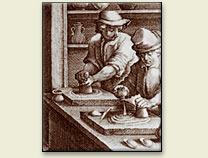Until paint was produced commercially during the Industrial Revolution (circa 1800), painters had to make their own paints by grinding pigment into oil. The paint would harden and would have to be made fresh each day. Paint consists of small grains of pigment suspended in oil. Although it appears smooth to the naked eye, on a microscopic level, particles of pigment are suspended in oil, as fruit in a Jello mold.
Oil paints do not "dry" by evaporation (as do watercolor paints); rather they harden through chemical reaction, as a Jello sets. Contact with the air causes oils to oxidize and to crosslink. The paint sets and hardens over time. Paints of different pigments dry at different rates. Charcoal black retards the drying (creating a slow-drying paint); ochre accelerates the drying (producing a quick-drying paint).

